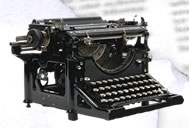Since
The New Look sought to overhaul the fashion silhouette of the female form it was quickly understood that women would need different foundation garments to complete this look. Fashion's cry has always been: "When nature doth deny, let art supply" - and the rocket scientists of the ladies underwear subculture did just that. The attached photo-essay from
See Magazine shows three pictures of the new under-lovelies.
Click here to learn about the lingerie and pajamas that had to be hand-crafted on the W.W. II American home front...
The California fashion critic who penned this article believed that the fashions of
Christian Dior stood firmly in opposition to the optimistic, Twentieth Century casual elegance of Claire McCardell (1905 – 1958) and Adrian (1903 – 1959). She could not bare Dior, with his vulgar penchant to spin
"the feminine figure in the unconventional manner, trying to make her look good where she ain't. He seeks the ballet dancer illusion - natural, rounded shoulders, too weak to support a struggling world...Her waist is pinched in an exaggerated indentation, the better to emphasize her padded hips...There are butterfly sleeves, box pockets, belled jackets, and barreled skirts, suggesting something like a Gibson girl, or whatever grandmother should have worn."
Click here to read a 1961 article about Jacqueline Kennedy's influence on American fashion.
"Weary of restraints imposed by more than a decade of war followed by the austerity program...British women have now cast aside the old look, are stampeding West End shops for the built-in New Look."
A former fashion model, Bobbie Woodward, was outraged when she awoke that morning in 1947 to find that the hidden hairy hand that decides which direction the fashion winds will blow had given the nod to some snail-eating Frenchman who stood athwart fashion's unspoken promise to continue the skirt hem's march ever-upward. Wasting no time, she quickly marshaled other equally inclined women and formed
The Little Below the Knee Clubs, which spread to forty-eight states (as well as Canada) in order to let the fashion establishment know that they would not be forced into wearing this fashion juggernaut known as "The New Look". The attached
See Magazine article serves as a photo-essay documenting the collective outrage of these women and their doomed crusade against Christian Dior.
One 1947 fashion critic believed that the New Look suffered from "a split personality". Click here to read her review.
When
Christian Dior died quite suddenly in 1957, the eggheads of the fashion world got their knickers in a twist as they wondered who would serve as the creative force for the great fashion house that he had established just ten years earlier; all eyes turned to his very young assistant, a 21 year old man named
Yves Saint Laurent (1936 – 2008).
Click here to read a 1961 article about Jacqueline Kennedy's influence on American fashion.
Contrary to popular thought, the "Fashion Police", so called, are not concerned with seemingly vulgar acts of dressing - mismatched colors, cheap accessories, gross fabrics, etc - but they do consider knocking-off the work of other designers as a serious violation - and when it comes to ripping-off the designs of Christian Dior or Pierre Balmain, that is when the Chambre Syndicale de la Haute Coutre and police inspector Jacques Besson step in.
"The fashionable gowns will be one of two extremes: pencil slim or big skirted like a puff ball. Whatever its cut, its color may be anything from soft dove grey to something called satan red. Fabrics are rich and lustrous, particularly the nontarnishable metallic materials. Newest is aluminum, colored gold or silver and woven into lame or onto rayon or even wool in gleaming designs."
"In the February of 1947, he opened eyes and mouths all over the world by showing almost-ankle-length daytime dresses. In the United States this length was christened the New Look. And Christian Dior had won, by inches the title, King of Fashion. His title is still secure. Dior designs accounted for an estimated 60% of total haute couture exports last year."
"Christian Dior, the Frenchman who covered up women's legs with his post-war 'New Look', has now decided that the female bosom must go. In fact, if Dior has his way, the feminine figure itself will go - the bust flattened to the backbone, the wasp-waist a thing of the past, the fair curve destined to be replaced by the washboard look of the 20s."
